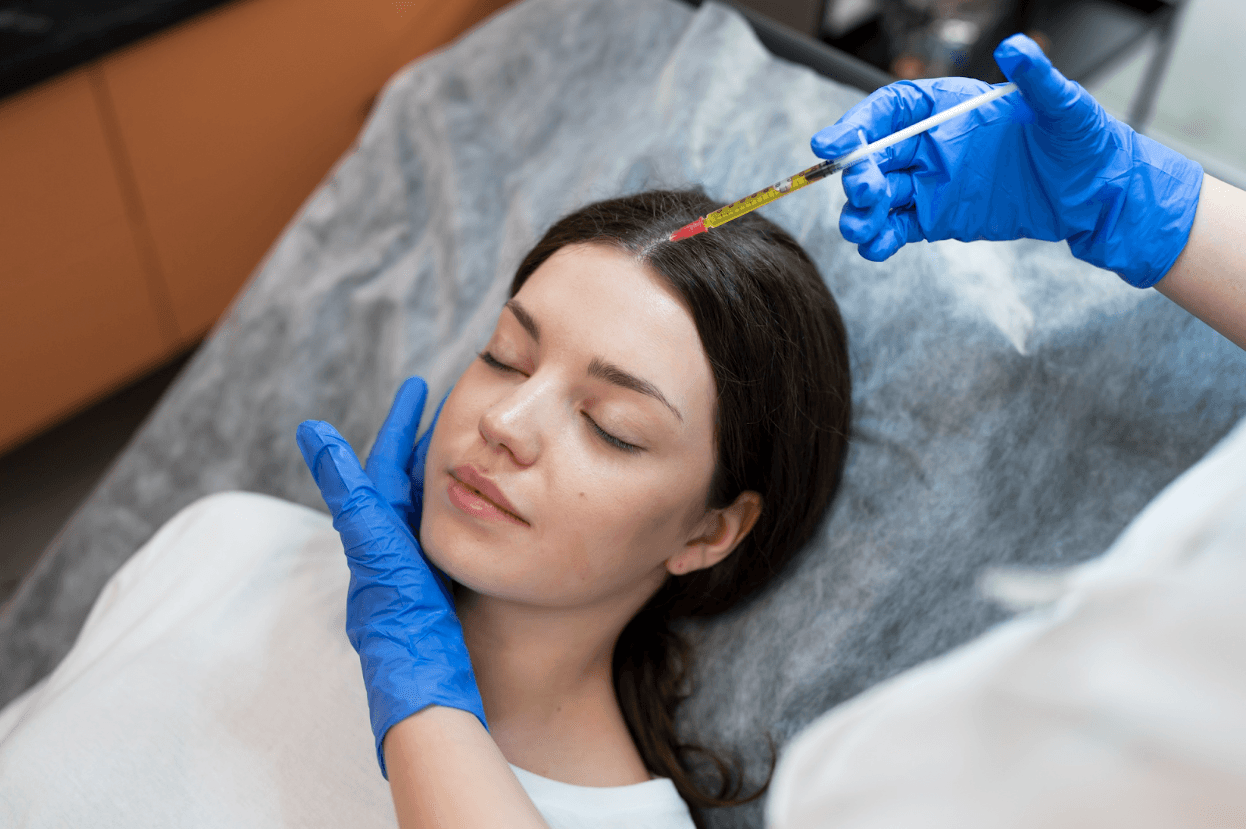PRP vs. PRF for Hair: What’s Better for Hair Regrowth? A Comprehensive Guide

Published on Mon Sep 15 2025

Losing your hair can be a gradual change or a sudden shift, but either way, it often affects confidence and self-image. Whether it’s thinning across the scalp, a receding hairline, or a widening part, many people start looking for treatments that are both safe and backed by science. Two options that have gained significant attention are Platelet-Rich Plasma (PRP) and Platelet-Rich Fibrin (PRF).
Both PRP vs PRF for hair treatment are blood-derived therapies supported by evidence-based clinical studies. Research shows that each can help in bringing back natural hair density by stimulating the scalp and encouraging stronger, healthier strands.
PRP and PRF are both effective for hair loss, but PRF is often considered the newer, more advanced approach. It offers a higher concentration of growth factors within a natural fibrin matrix, releasing them slowly over time for sustained benefits. Knowing how each treatment works, and the differences between them, can make it easier to decide which is right for your hair restoration goals.
What Is PRP (Platelet-Rich Plasma)?
Before decoding the difference between PRP vs PRF, let us individually assess them.
PRP or Platelet-Rich Plasma, is a type of regenerative therapy used in medical science. For decades, it has played a role in orthopedics, dentistry, and dermatology before becoming widely recognized for hair restoration.
How PRP Works:
- A small blood sample (30–60 ml) is drawn from your arm.
- The sample is placed into sterile tubes and processed in a centrifuge.
- Heavier components (RBCs) settle at the bottom, while plasma rises to the top.
- The platelet-rich plasma layer contains growth factors that stimulate follicles.
Key Growth Factors in PRP:
- PDGF: Cell growth, blood vessel formation, collagen production
- TGF-β: Cell differentiation, extracellular matrix formation
- VEGF: Blood vessel formation (angiogenesis)
- EGF: Cell growth and differentiation
- FGF: Tissue repair and proliferation
Injected PRP stimulates dormant follicles, prolongs the anagen (growth) phase, and encourages thicker, stronger shafts.
What Is PRF (Platelet-Rich Fibrin)?
PRF (Platelet-Rich Fibrin) is a second-generation PRP and one of the most advanced autologous regenerative treatments.
How PRF Differs:
- Prepared with a slow, soft spin centrifugation (lower speed than PRP).
- No anticoagulants added — fibrin forms naturally.
- Fibrinogen converts into a 3D fibrin matrix that traps platelets, WBCs, and stem cells.
- The fibrin matrix slowly releases growth factors over 7–10 days (vs. hours in PRP).
Benefits of PRF:
- Enhanced Healing through sustained release
- Richer Cellular Content (platelets, leukocytes, stem cells)
- Natural Scaffold for tissue regeneration
- No Additives, making it purer and safer
Injected PRF continuously nourishes follicles, improves circulation, and supports long-lasting growth.
Key Differences Between PRP and PRF
Here’s a side-by-side comparison:
| Criteria | PRP (Platelet-Rich Plasma) | PRF (Platelet-Rich Fibrin) |
|---|---|---|
| Full Form | Platelet-Rich Plasma | Platelet-Rich Fibrin |
| Generation | First-generation regenerative therapy | Second-generation regenerative therapy |
| Preparation Method | Higher speed centrifugation, typically two spins | Lower speed, single-step centrifugation (soft spin) |
| Anticoagulants | Used (e.g., ACD-A) | Not used — natural clotting forms fibrin |
| Fibrin Matrix | Absent | Present (3D scaffold) |
| Growth Factor Release | Immediate burst, shorter duration | Sustained release (7–10 days) |
| Cellular Composition | Mainly platelets, few WBCs | Platelets, diverse WBCs, stem cells |
| Duration of Effect | Shorter, requires frequent sessions | Longer-lasting per session |
| Cost Per Session | Lower | Higher |
Pros & Cons of PRP vs PRF
PRP Pros:
- Cost-effective per session
- Widely available
- Quick preparation
PRP Cons:
- Shorter release of growth factors
- Requires more sessions
PRF Pros:
- More sustained release of growth factors
- Fibrin scaffold supports regeneration
- Fewer sessions needed
PRF Cons:
- Higher cost
- Not as widely available yet
Who Should Choose PRP or PRF?
PRP is ideal for:
- Budget-conscious patients
- Early-stage hair thinning
- Maintenance therapy post-transplant
PRF is ideal for:
- Moderate to severe thinning
- Patients seeking sustained results
- Those with poor response to PRP
Cost Comparison: PRP vs PRF
| City | PRP Cost/Session (INR) | PRP Cost/Session (USD) | PRF Cost/Session (INR) | PRF Cost/Session (USD) |
|---|---|---|---|---|
| Mumbai | ₹5,000 – ₹15,000 | $60 – $180 | ₹10,000 – ₹20,000 | $120 – $240 |
| Delhi | ₹6,500 – ₹15,000 | $78 – $180 | ₹12,000 – ₹30,000 | $144 – $360 |
| Bengaluru | ₹5,000 – ₹12,000 | $60 – $144 | ₹8,000 – ₹18,000 | $96 – $216 |
| Chennai | ₹4,000 – ₹12,500 | $48 – $150 | ₹8,000 – ₹18,000 | $96 – $216 |
| Hyderabad | ₹7,000 – ₹12,000 | $84 – $144 | ₹10,000 – ₹20,000 | $120 – $240 |
FAQs
Q1. Does PRF regrow hair permanently?
No, neither PRP nor PRF cure hereditary hair loss. Both stimulate dormant follicles and thicken existing hair.
Q2. Does PRF last longer than PRP?
Yes, PRF generally lasts longer due to its fibrin matrix and sustained release.
Q3. Is PRF better than PRP for growth factors?
Yes, PRF contains more regenerative cells and has slower, more effective release.
Q4. Why is PRF more expensive than PRP?
Because of its advanced preparation, higher blood volume, and superior biological benefits.
Q5. Should I get PRP or PRF?
It depends on your stage of hair loss, budget, and treatment goals.
Final Takeaway
Hair restoration treatments are evolving rapidly. Both PRP and PRF are safe, effective, and minimally invasive.
- PRP: Cost-effective, good for early stages & maintenance.
- PRF: More advanced, sustained results, fewer sessions.
👉 Want to know which is right for you? Book a consultation with Kibo Clinic experts for a personalized plan.